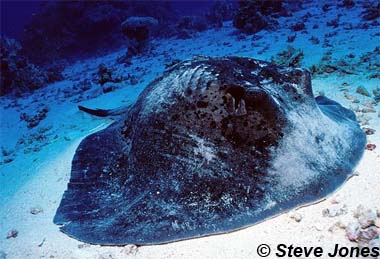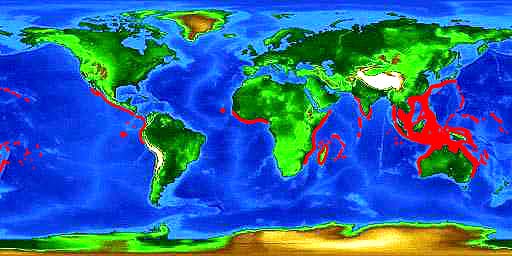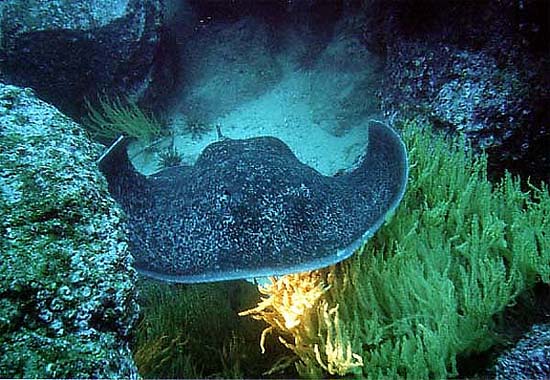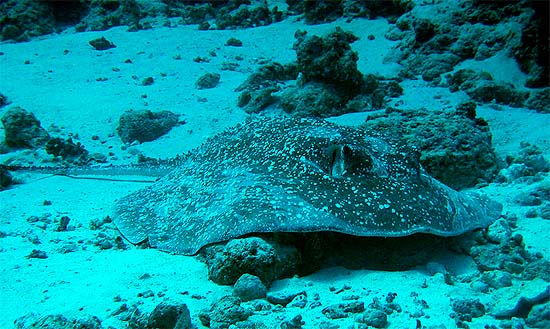
Taeniura meyeni
This large stingray can grow to almost 6 feet wide and over 300 pounds. The pectoral disc is very round, with black, white and gray splotches across its brown to grey to purplish top, and a white underside. The tapering tail is usually slightly shorter than the body length, and has a venomous spine it uses as defense.
Although it is non-aggressive and generally prefers coral reefs and sandy bottoms, it should be treated with caution because of its curiosity to humans and its ability to inflict a painful wound with its spine.
Order: Myliobatiformes
Family: Dasyatidae
Genus: Taeniura
Species: meyeni
Common Names
English language common names are blotched fantail ray, black spotted ray, black-blotched stingray, black-spotted ray, fantail ray, fantail stingray, giant reef ray, round ribbontail ray, and speckled stingray. Other common names include faiyenecheoligilifeo (Carolinian), gespikkelde waaierstaartpijlstaartrog (Dutch), giluga-tirike (Telugu), krabane lai-hin-orn (Thai), likhmah al munaqatah bil asraq (Arabic), madara ei (Japanese), marmorrocka (Swedish), meet (Carolinian), nyenga (Swahili), pagi (Tagalog), pari babi (Bahasa), pari reben (Malay), pastenague à taches noires (French), pastenague éventail (French), raie à tache noire (French), raie brisant (French), raie noire (French), ratão cauda redonda (Portuguese), raya manchada (Spanish), sartén marmoleado (Spanish), sortplettet pigrokke (Danish), trnucha velkoskvrnitá (Czech), tubaq (Arabic), vai da (Fijian), vali (Gela), vé-në (Numee), and védaa (Numee).
Importance to Humans
The blotched fantail ray is commonly caught by demersal tangle net fisheries as well as by longline and bottom trawl fisheries throughout much of its range. It is also taken by recreational surf and ski boat fishers off of South Africa but is typically released unharmed. It is also taken as bycatch by offshore trawlers in waters off southern Africa.
The blotched fantail ray is not a hardy specimen for the aquarium trade as the longest record for maintaining a specimen in captivity is a mere 81 days.
Danger to Humans
Although not typically aggressive, this ray has been responsible for at least one known human fatality. If handled, the blotched fantail ray should be treated with respect and caution due to the spines on the tail which could potentially cause severe injury.
Conservation
> Check the status of the blotched fantail ray at the IUCN website.
The IUCN is a global union of states, governmental agencies, and non-governmental organizations in a partnership that assesses the conservation status of species.
In Southeast Asia, significant fishing pressure on batoids (rays) exists through targeted fisheries as well as via bycatch in other fisheries. The meat and cartilage of the blotched fantail ray are utilized in this region. Juvenile blotched fantail rays are also taken by prawn and fish trawlers is waters around Indonesia. In Australian waters, this species is discarded bycatch in the prawn trawl fisheries. Unfortunately it is considered among the least sustainable elasmobranch bycatch in the fishery due to its susceptibility to capture and mortality rates upon release. However, in the future the mandatory use of Turtle Exclusions Devices in prawn trawl fisheries operating off northern Australia (including the NPF and the Queensland East Coast Trawl Fishery) should limit the catch of this species in these fisheries. Additional pressure exists on the habitat of this species throughout Asia and across its range in the Indian Ocean in the form of destructive fishing practices using dynamite as well as run-off impacting reef systems that comprise the main habitat of this ray.
The blotched fantail ray has been afforded some protection through the creation of marine protected areas including the Great Barrier Marine Park in Australia as well as in marine reserves around popular diving sites in the Maldives to encourage ecotourism. In the mid 1990s, the Maldives went so far as to ban the export of rays and the export of ray skins also to further protect this valuable tourism resource.
Geographical Distribution

The blotched fantail ray is found in the Indo-west Pacific region including the Red Sea and off East Africa to southern Japan, Micronesia, and tropical Australia. Off the coast of Australia, it is known from the central coast of Western Australia, around the tropical north of the country and south on the eastern coast as far northern as New South Wales and Lord Howe Island. In the eastern Pacific Ocean, this species is known only from the oceanic islands – Cocos and the Galapagos – where it is very common. However, because of its sheer numbers, individuals have been reported off the Pacific coast of Central America.
Habitat
This tropical species associates with coral reefs and sandy bottoms in shallow lagoons to the outer reef slopes. Depths where the blotched fantail ray resides range from shallow waters to depths of 1,640 feet (500m), however it is more commonly observed from 66-197 feet (20-60m). It is observed either singly or in aggregates and often with jacks and cobia swimming in close proximity.
Biology

Distinctive Features
The blotched fantail ray is a large stingray with a flattened, circular-shaped disc with pectoral fins that are broadly expanded and joined to the head and disc. The disc lacks thorns. There is a prominent, deep ventral skin fold that extends to the tip of the tail. The narrow tail is distinctly demarcated from the body. When undamaged, the depressed tail is slightly longer than the disc.
Coloration
The botched fantail ray gets its common name from its coloration and the tail flap. The dorsal surface of this ray consists of a pattern of black, gray, and white blotches and spots which end at the edges of the circular disc. This coloration pattern continues along the tail to the one or two spines where the mottled coloration changes to black or dark gray. The edges of the disc and the ventral surface are white.
Dentition
Inside the mouth, the numerous small teeth are arranged in plates and used for crushing prey such as mollusks and crabs.
Denticles
Thorns are absent on the body of the blotched fantail ray.
Size, Age, and Growth
The maximum reported length of this large stingray is 10.8 feet (3.3m) total length (TL) and the maximum reported weight is 331 pounds (150kg). The maximum disc width is 5.9 feet (1.8m) DW which correlates to approximately 10.8 feet (3.3m) TL. In contrast, the smallest free swimming specimen recorded measured 13 inches (33cm) DW. The size of the blotched fantail ray is approximately 13.8 inches (35cm) DW, 26.4 inches (67cm) TL. Males reach maturity at a total length of 39.8-43.3 inches (100-110cm).
Food Habits
The blotched fantail ray feeds on bottom fish, bivalves, crabs and shrimp. Its ventrally positioned mouth is well-adapted for scooping up prey found hiding in sandy bottoms.

Reproduction
As an ovoviviparous species, the embryos of this species feed initially on yoke, followed by additional nourishment from the mother through the indirect absorption of uterine fluid which is enriched with mucus, fat, and protein through specialized structures. Although little is known about the biology of the blotched fantail ray, it is known to have a small litter size of up to seven young. At birth, each juvenile measures approximately 13.8 inches (35 cm) DW and 26.4 inches (67 cm) TL.
Predators
Potential predators of stingrays include marine mammals and large fish such as sharks.
Parasites
Dendromonocotyle pipinna n. sp. (Monogenea: Monocotylidae) has been described from the dorsal skin surface of Taeniura meyeni from a public aquarium located in Australia.
Taxonomy
The blotched fantail ray was originally described as Taeniura meyeni by Müller & Henle in 1841. Synonyms include Taeniura melanospila Bleeker 1853, Taeniura melanospilos Bleeker 1853, and Taeniura mortoni Macleay 1883. It is more widely know as its junior synonym T. melanospila which was based on the description of a juvenile specimen. The genus name, Taeniura, is derived from the Latin “taenia” meaning “stripe” and the Greek “oura” meaning “tail”, referring to the coloration of the tail. It is a member of the Dasyatidae family.
Prepared by: Cathleen Bester